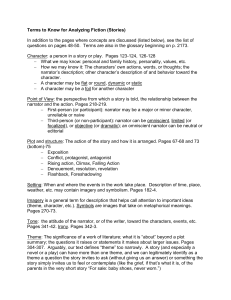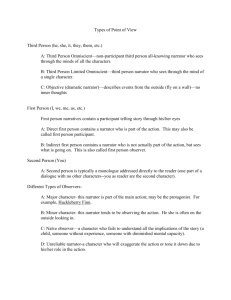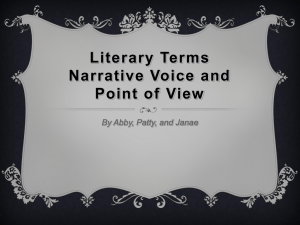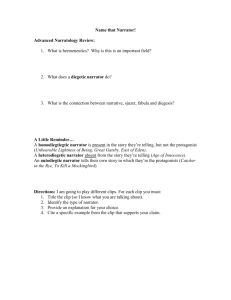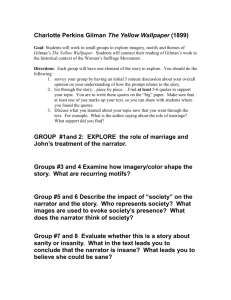AP Vocabulary List #1 - AP Language and Composition
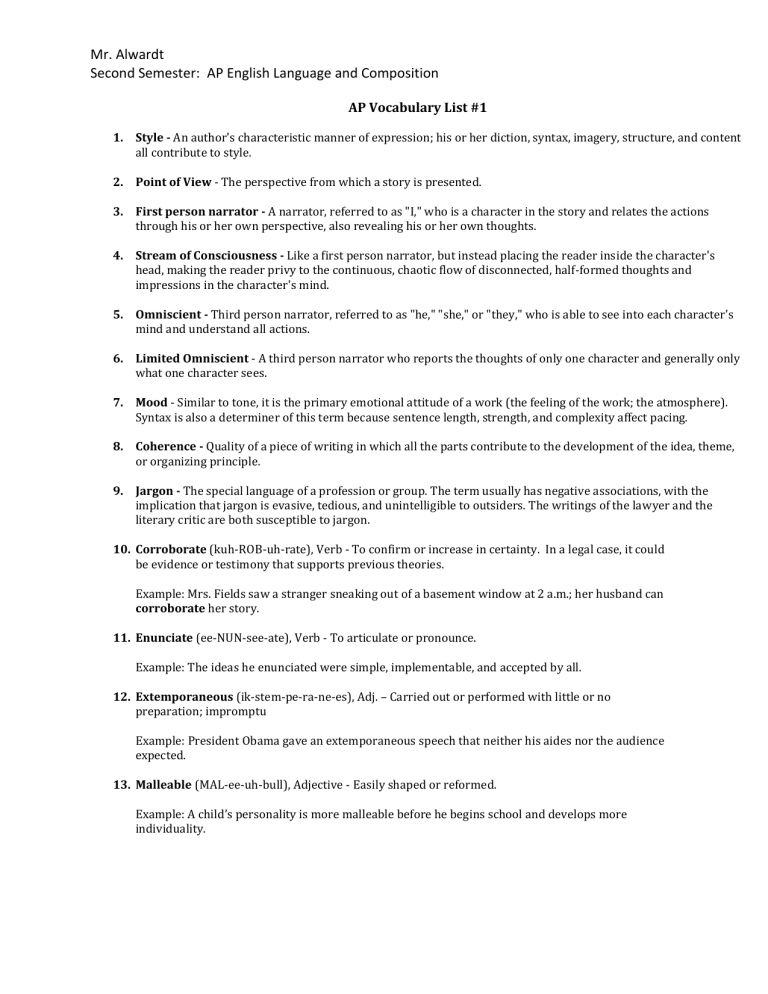
Mr. Alwardt
Second Semester: AP English Language and Composition
AP Vocabulary List #1
1.
Style - An author's characteristic manner of expression; his or her diction, syntax, imagery, structure, and content all contribute to style.
2.
Point of View - The perspective from which a story is presented.
3.
First person narrator - A narrator, referred to as "I," who is a character in the story and relates the actions through his or her own perspective, also revealing his or her own thoughts.
4.
Stream of Consciousness - Like a first person narrator, but instead placing the reader inside the character's head, making the reader privy to the continuous, chaotic flow of disconnected, half-formed thoughts and impressions in the character's mind.
5.
Omniscient - Third person narrator, referred to as "he," "she," or "they," who is able to see into each character's mind and understand all actions.
6.
Limited Omniscient - A third person narrator who reports the thoughts of only one character and generally only what one character sees.
7.
Mood - Similar to tone, it is the primary emotional attitude of a work (the feeling of the work; the atmosphere).
Syntax is also a determiner of this term because sentence length, strength, and complexity affect pacing.
8.
Coherence - Quality of a piece of writing in which all the parts contribute to the development of the idea, theme, or organizing principle.
9.
Jargon - The special language of a profession or group. The term usually has negative associations, with the implication that jargon is evasive, tedious, and unintelligible to outsiders. The writings of the lawyer and the literary critic are both susceptible to jargon.
10.
Corroborate (kuh-ROB-uh-rate), Verb - To confirm or increase in certainty. In a legal case, it could be evidence or testimony that supports previous theories.
Example: Mrs. Fields saw a stranger sneaking out of a basement window at 2 a.m.; her husband can
corroborate her story.
11.
Enunciate (ee-NUN-see-ate), Verb - To articulate or pronounce.
Example: The ideas he enunciated were simple, implementable, and accepted by all.
12.
Extemporaneous (ik-stem-pe-ra-ne-es), Adj. – Carried out or performed with little or no preparation; impromptu
Example: President Obama gave an extemporaneous speech that neither his aides nor the audience expected.
13.
Malleable (MAL-ee-uh-bull), Adjective - Easily shaped or reformed.
Example: A child’s personality is more malleable before he begins school and develops more individuality.
Mr. Alwardt
Second Semester: AP English Language and Composition
14.
Allusion - A reference to a well-known person, place, or thing from literature, history, etc.
Example:
My wife: “What do you want for Christmas?”
Me: “Nothing!”
My wife: “OK, Scrooge.”
15.
Analogy - A point-by-point comparison of two similar but different things, usually to clarify an action or a relationship.
Examples:
Red is to apple as yellow is banana.
Shells were ancient culture as dollar bills are modern American culture.
Running a business is like managing an orchestra.
The heart is like a pump.
16.
Aphorism - A short, often witty statement of a principle or a truth about life.
Examples:
"Early bird gets the worm."
"What goes around, comes around."
"People who live in glass houses shouldn't throw stones."
17.
Figurative Language - Language that contains figures of speech, such as similes and metaphors, in order to create associations that are imaginative rather than literal. It’s basically the blanket term for every literary device you know.
18.
Imagery - Words or phrases that use a collection of images to appeal to one or more of the five senses in order to create a mental picture.
Examples:
The smoke in the room was so dense it burned my eyes.
The siren pierced my ears as the red fire truck zoomed past me.
19.
Personification - the attribution of human nature or character to animals, inanimate objects, or abstract notions, especially as a rhetorical figure.
20.
Parallelism - The technique of arranging words, phrases, clauses, or larger structures by placing them side by side and making them similar in form. It’s expressing ideas of equal worth in the same grammatical form.
Examples:
Today we are living, learning and laughing.
It is by logic we prove, but by intuition we discover.
Faulty parallelism: Yesterday I went hiking, jogging, and took my dog for a walk.




